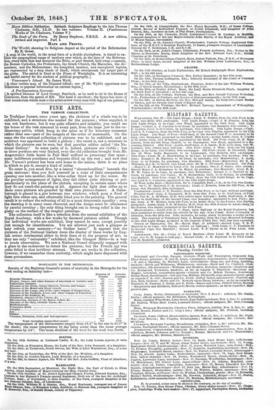FINE ARTS.
THE VERNON COLLECTION.
IN Trafalgar Square, some years ago, the skeleton of a whale was to be exhibited, and a structure was needed for the purpose : when supplied, it Was not handsome, but it was quite effective and suitable; you could see the bones of the vast mammal in every part, from the huge jaw to the ru- dimentary pelvis, which hung to the spine as if for honorary ornament rather than use-part of the insignia of the order of mammalia. On the same site the national collection of pictures was to be exhibited, and an architect was appointed to build a gallery : the result is, not a structure in which the pictures can be seen, but that peculiar edifice called "the Na- tional Gallery." In some parts of it, indeed, pictures are visible ; but as those portions are very limited, even the old collection brought from Mr. Angerstein's little house in Pall Mall sufficed to preoccupy that space ; some indifferent purchases and bequests filled up the rest ; and now that Mr. Vernon's present has been sent home to the nation, there is no place ia which to put it, except a kind of cellar.
To enter it, you must dive, by a lateral " circumbendibus," beneath the great staircase: then you find yourself in a suite of little compartments opening one into another, like a wine-cellar fitted up for the nonce. By the peculiar arrangement of lights, they fall either quite sidelong or per- pendicularly to the plane of the picture, excepting in certain cases where they do not reach the painting at all. Against the light that sidles up to them some pictures are guarded by their own picture-frames. A Gains- borough is placed in a pier between two windows, which pour a flood of light into either eye, and effectually blind you to the painting. The general result is to reduce the colouring of all to a most democratic equality : even the drawing is in many cases obscured, and the design must be eliminated by careful scrutiny ; the only thing brought out in strong relief is the ru- gosity on the surface of the rougher paintings.
The collection itself is like a selection from the annual exhibition of the Royal Academy, with a few works by deceased painters added. Though the individual works are exhibited, they cannot be seen, except possibly just enough for identification. You are allowed just such a glimpse as may refresh your memory-" no further harm." It appears that the curators of the National Gallery deem the display of these works by Eng- lish artists detrimental either to their fame or to the progress of art; so they are only " colourably " exhibited, like the Glasgow Bible-in a way to evade observation. We saw a National Guard diligently engaged with a glass in the endeavour to detect the pictures; but the French spy was quite foiled in that invidious attempt. There are works in the collection, however, if we remember them correctly, which might have dispensed with these precautions.


























 Previous page
Previous page